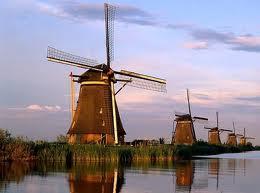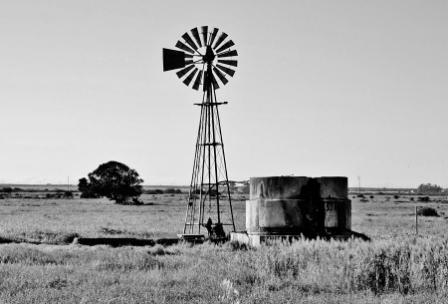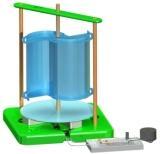Types of wind energy conversion devices
Types of wind energy conversion devices
Wind energy conversion devices can be broadly categorized into two types according to their axis alignment. They are as follows
Horizontal axis wind turbine:
It can be further divided into three types:
- Dutch type grain grinding wind mills
- Multiblade water pumping windmills
- High speed propeller type windmills
1. Dutch Windmill:
Man has used Dutch windmills for a long time. In fact the grain grinding windmills that were widely used in Europe since the middle ages were Dutch. These windmills were operated on the thrust exerted by the wind. The blades, generally four, were inclined at an angle to the plane of rotation. The wind being deflected by the blades exerted a force in the direction of rotation. The blades were made of sails or wooden slats.

2. Multiblade Water Pumping Windmill:
Modern water pumping windmills have a large number of blades- generally wooden or metallic- driving a reciprocating pumps. As the mill has to be placed directly over the well, the criterion for site selection concerns about water availability & not windiness. Therefore the mill must be able to operate at slow winds. The large number of blades gives a high torque, required for driving a centrifugal pump, even at low wind speeds. Hence sometimes these are called as fan mills. As these windmills are supposed to be installed at remote places, mostly as single units, reliability, sturdiness, and low cost are the prime criteria and not efficiency. The blades are made of flat steel plates, working on the thrust of wind. These are hinged to a metal ring to ensure structural strength, and the low speed of rotation adds to the reliability. The orientation is generally achieved by tail vane.

3.High speed propeller type wind machines:
The horizontal axis wind turbines that are used today for electricity generation do not operate on thrust force. They depend mainly on the aerodynamic forces that develop when wind flows around a blade of aerofoil design. Windmills working on thrust force are inherently less efficient. So all the modern wind turbine blades are designed based on aerofoil section.
Vertical axis wind turbines:
It comes in two different designs
- The savonius rotor
- The darrieus rotor
1.The savonius rotor:
The savonius rotor is extremely simple vertical axis device that works entirely because of the thrust force of wind. The basic equipment is a drum cut in two halves vertically. The two parts are attached to the two opposite sides of a vertical shaft. As the wind blowing into the structure meets with two dissimilar surfaces – one convex and the other concave – the forces exerted on the two surfaces are different, which gives the rotor a torque. By providing a certain amount of overlap between the two drums, the torque can be increased. This is because the wind blowing into the concave surface turn around and give a push to the inner surface of the other drum, partly cancelling the wind thrust on the convex side. It has been found that an overlap of about one third the drum diameter gives optimum result.

2. The darrieus wind turbine:
The particularity of Darrieus rotor is that its working is not at all evident from its appearance. Two or more flexible blades are attached to a vertical shaft. The blades bow outwards, taking approximately the shape of a parabola and are of symmetrical airfoil section. Here the torque is zero when the rotor is stationary. It develops a positive torque only when it is already rotating. This means that such a rotor has mo starting torque and has to be start using some external means.

3. Giromill:
A variant of Darrieus wind turbine is the Giromill which uses the same concept. Here the blades are straight resulting in simple construction. However in such a case the centrifugal force developed in the blade will produce stress, trying to bend it. The blades have to be strong enough in the transverse direction to withstand this stress. Moreover the vertical shaft cannot be secured with guywires, and so the coupling at the base has to be strong enough to keep it vertical when subjected to strong winds. It is also called as H-Type windmill because of its shape.
Source and References: S. N. Bhadra, D. Kastha, and S. Banerjee: “Wind Electrical Systems”, 1st Edition, Oxford publications.
Last Modified : 3/2/2020
